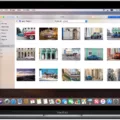If you’re a Mac user, you know that Macs are powerful machines that offer excellent performance and reliability. But do you know how to check the RAM on your Mac? Checking the RAM on your Mac is a simple process that can give you important information about how much RAM your computer has and whether it is running efficiently.
To check the RAM on your Mac, first open the Activity Monitor application. This can be found in Applications > Utilities folder. Once the application is open, go to the System Memory tab. Here you will find detailed infomation about the type of RAM installed in your computer, as well as how much of it is being used at any given moment.
The System Memory tab will show you two types of memory: physical memory and virtual memory. Physical memory refers to the amount of RAM installed in your computer, while virtual memory refers to additional space provided by the hard disk drive when physical memory is running low. You can also see how much RAM is being used for applications and processes, along with how much idle memory there is available for other tasks.

Another way to check the amount of RAM installed in your computer is to go to Apple Menu > About This Mac > Storage tab. Here you will find an overview of all storage devices connected to your Mac, including RAM modules. You can also see which type of RAM module each slot uses (DDR3 or DDR4).
Finally, if you need more detailed information regardng your Mac’s system memory, you can use a third-party utility such as iStat Menus or Drive Genius 4. These utilities provide more extensive details about system resources like processor usage, RAM usage and swap files, helping you identify any potential problems with system performance or stability.
By taking some time to check the RAM on your Mac regularly, you can ensure that it runs smoothly and efficiently over time. With this knowledge in hand, you’ll be able to take btter care of your machine so it continues performing at its best for years to come!
Freeing Up RAM on a Mac
Freeing up RAM on your Mac is an effective way to improve the performance of your device. To do this, tere are a few steps you can take:
1. Close any applications that you’re not currently using. Doing so will free up RAM that wold otherwise be taken up by those programs.
2. Make sure to keep your desktop tidy and clear of unnecessary applications and files. Having too much clutter on your desktop can cause your computer to slow down and use more RAM than necessary.
3. Stop programs from starting automatically when you boot up your Mac. This can be done by going into System Preferences > Users & Groups > Login Items and disabling any items that don’t need to run automatically when you start up your system.
4. Shut down web browser tabs that you’re not actively using, as thse can use a surprising amount of RAM if left open for long periods of time.
5. Delete any unnecessary browser extensions, as these could also be usig extra RAM without you realizing it.
6. Finally, make sure you have plenty of free disk space on your Mac, as a full hard drive can slow down performance and case more RAM to be used than necessary.
Checking RAM Usage
To check how much RAM you have, begin by clicking on the Start button. Next, type ‘System Information’ in the search bar and click on the app when it appears. Once in the System Information window, scroll down until you find ‘Installed Physical Memory’. Here, you’ll be able to locate details about how much RAM is installed on your computer. If you need more information about your RAM, you can use a program called CPU-Z which provides comprehensive information about your CPU.
Checking Processor and RAM on a Mac
To check your processor and RAM on a Mac, first click the Apple icon in the top-left corner of your screen. This will bring up a drop-down menu. Select the option ‘About This Mac’. This will open a window which will show you detailed information about your Mac’s hardware, including the processor speed, RAM and graphics card. You can also click ‘System Report’ at the bottom of this window to get more advanced information about your Mac’s hardware.
Understanding the Causes of High RAM Usage on Mac Computers
Your Mac’s RAM is like a “working memory” for your computer, and it can fill up quickly if you have too many applications running at once. The more applications you have open, the more RAM will be used. Additionally, some older apps may not be optimized for modern computer architecture, so they can cause your Mac to use more RAM than necessary. You can check whih apps are using the most RAM by going to Activity Monitor in your Utilities folder. If an application is using too much RAM, it may help to close the app or try an updated version of the app if available.
Managing RAM on Mac
Managing RAM on your Mac is important for keeping your computer running smoothly and efficiently. Fortunately, it’s a fairly straightforward process that can be accomplished in a few steps.
First, restart your Mac. This is the simplest way to free up RAM and can be done by clicking the Apple icon in the top-left corner of the screen and selecting “Restart.”
Second, you can free up RAM with Terminal by entering specific commands into the command line. This may require some research to determine which commands will best suit your needs, but it can be an effective way of freeing up RAM if used properly.
Third, there are various third-party tools available that can help you manage RAM more effectively. These tools will usually have a user-friendly interface that makes it easy to adjust RAM usage settings without having to enter any commands in Terminal.
Fourth, tidy up your desktop by removing old files that you no longer need or use. This will help reduce strain on your computer’s memory and speed up its performance overall.
Fifth, disable login items from automatically opening when you start up your Mac. These programs can take up a lot of RAM and slow down startup time significantly. To do this, go to System Preferences > Users & Groups > Login Items tab and uncheck any programs you don’t want to open automatically when you log in.
Sixth, keep fewer Finder windows open at once as these will take up additional memory resources if left open for extended periods of time.
Seventh, close browser tabs that aren’t being used as these also consume memory resources wile open in the background even if they aren’t actively being used at the moment.
Finally, remove unused browser extensions as these add extra memory overhead when browsing the internet and are oftn unnecessary if they don’t provide any added benefit or feature to your browsing experience.
Is 8GB of RAM Sufficient?
Yes, 8GB of RAM is usually enough for most people. It provides enough memory for multitasking and running multiple applications at the same time without lag. 8GB of RAM also allows you to have a large number of open tabs in your browser and still have a smooth experience. Additionally, 8GB of RAM is plenty if you plan on gaming on your phone or tablet as it can handle more graphically intensive games. In short, 8GB of RAM should be plenty for most people’s needs.
Is 16GB of RAM a Good Choice?
Yes, 16GB RAM is a good choice for most users. It provides enugh memory to run current games and software without any significant slowdowns. It also can handle multitasking and other intensive tasks with ease. With 16GB RAM, you will not have to worry about your computer slowing down or encountering memory-related issues due to lack of available RAM. This makes it an ideal option for those who use their computers for gaming, video editing, music production, or any other intense activity that requires the processing power of a desktop. Additionally, 16GB RAM is also useful for future-proofing as more demanding applications are released in the years to come.
Is 8GB of RAM Sufficient for Gaming?
For most gaming scenarios, 8GB of RAM is enough to play games at a satisfactory level. With 8GB RAM, you can expect to be able to play most modern games with no major issues. However, tere are some games that may require more RAM for optimal performance or higher quality graphics settings, and you may need to shut down other applications in order to prevent memory overload. If you are playing a particularly demanding game or want the highest quality graphics possible, you may consider investing in a higher amount of RAM for your gaming PC.
Determining How Much RAM is Installed
You can find out how much RAM you have installed by going to Settings > System > About and looking for the Device Specifications section. The line named “Installed RAM” will tell you the amount of RAM currently installed in your device. The amount is usually listed in gigabytes, for example 8GB or 16GB.
Checking Mac Specifications
To check your Mac specs, open the About This Mac window. You can find it by going to the Apple menu in the top left corner of your screen and selecting About This Mac. In this window you’ll be able to view a general overview of your Mac’s hardware and software specifications. This includes information about your Mac model name, processor type, memory size, macOS version, serial number, and more.
How to Determine the Memory of My Mac
Your Mac’s memory is determined by the type of processor and amount of RAM (Random Access Memory) installed. To find out how much RAM your Mac has, click on the Apple menu in the top left corner of your screen and select ‘About This Mac’. You will be presented with a window that displays information abot your Mac, including its processor speed and the amount of RAM installed. Depending on your Mac model, this could range from 4GB to 32GB or more.
Freeing Up RAM
The first step to freeing up RAM is to restart your device. This will clear temporary files, processes and other data stored in RAM that are no longer needed. You can also try using other browsers or clearing the RAM cache to free up additional RAM. It’s also important to keep your software up-to-date, as this can improve its performance and help free up RAM. If you’re not using any extensions or plugins, delete them as well since these can consume RAM resources. Finally, use Windows Task Manager to monitor your RAM usage and identify any processes that may be consuming too much of it. By folowing these steps, you should be able to get more out of your device’s available RAM.
Do I Need More RAM?
If you’re wondering whether or not your computer needs more RAM, there are severl signs that may indicate a need for an upgrade. Firstly, if your computer is randomly freezing, this could be a sign that it needs more RAM. Similarly, if your computer is randomly rebooting or crashing, this could also be an indication that it needs more RAM. Secondly, if your computer’s memory usage is high (over 75%), this may be another indication that you need to upgrade your RAM. Thirdly, if you’re experiencing lag when typing or using programs and apps, this could also be an indication of low RAM. Fourthly, if programs and apps are not responding when you attempt to open them, this could also be a sign of needing more RAM. Lastly, if you experience the dreaded ‘Blue Screen of Death’, then this is almost certainly a sign that you need to increase the amount of RAM in your system. If any of these signs apply to your computer, then it may well be time to invest in additional RAM.
Is 32 GB of RAM Excessive?
In most situations, 32GB of RAM is not necessary, and could be considered overkill. However, cetain tasks and activities may require more memory than the average user has available. For example, if you are a video editor or run heavy software programs such as Photoshop or 3D modeling, you may find that you need more than the standard 8GB of RAM that comes with most laptops and desktop computers. In addition, if you intend to use your computer for gaming or other intensive activities such as virtual reality (VR), 32GB of RAM could be beneficial.
For general everyday use, 32GB of RAM is not necessary. Most users will find that 8GB is more than sufficient for web browsing, streaming media and basic photo editing. However, if you plan to use your computer for tasks that require a lot of memory such as video editing or VR gaming, then 32GB of RAM can be beneficial in order to futureproof your PC and ensure that it will continue to meet the increasing requirements of modern software and games.
Which Is Better: 8GB or 16GB RAM?
It relly depends on your usage. 8GB of RAM is likely enough for basic tasks like web browsing, word processing, and light gaming. 16GB of RAM is better if you’re doing more intensive tasks like video editing and 3D rendering. If you’re using your computer for gaming in particular, 16GB of RAM is probably a good investment, as it will help you get the most out of your gaming experience. In some cases, 32GB or even 64GB may be necessary depending on the type of game and other features you are running.
Is 64GB of RAM Excessive?
64GB of RAM is considered to be overkill for most users, as the majority of people will not need that much RAM. For basic everyday activities, such as browsing the web, sending emails, and streaming media, 8GB of RAM is more than enough.
For those who want to use their computer for gaming or more intensive tasks such as video editing or graphic design, 16-32GB of RAM may be necessary. Having 64GB of RAM can help with multitasking and reduce the time it takes to complete certain tasks. However, it is important to keep in mind that having too much RAM can cause your system to slow down due to lack of efficiency in memory usage.
In short, 64GB of RAM may be overkill for most users; hwever if you are an avid gamer or have a job that requires heavy multitasking and intense applications then 64GB might be beneficial for you.
The Impact of Excessive RAM Usage
It really depends on the user’s neds and requirements. Generally speaking, 4GB of RAM is sufficient for day-to-day tasks such as web browsing, word processing, and streaming media. For more intensive activities such as gaming or video editing, 8GB to 16GB of RAM is recommended. For hardcore gamers and power users, 32GB to 64GB of RAM may be necessary. However, any more than 64GB may not give much additional benefit and could be considered excessive. Ultimately, it comes down to the individual’s needs and budget.
Comparing RAM and SSD: Which is Better?
The answer to this question depends on what you are looking for in terms of performance. RAM is significantly faster than an SSD, so if you need quick access to large amounts of data, RAM is the way to go. However, if you want more permanent storage space for your data, an SSD would be a bettr choice. While RAM is great for quickly accessing data that is currently being used, it doesn’t provide as much storage capacity as an SSD does. Additionally, data stored in RAM is volatile and can be lost if there is a power outage or other unexpected event. Therefore, while both RAM and SSDs have their advantages, they are best suited to different tasks.
Benefits of Upgrading RAM from 8GB to 16GB
Upgrading your RAM from 8GB to 16GB can be a great investment for your gaming PC. Although 8GB of RAM was enough for many years, new AAA PC games like Cyberpunk 2077 are requiring 8GB of RAM and recommending up to 16GB. Having 16GB of RAM will provide you with a more future-proof build and alow you to run the latest games without fear of running out of RAM. Additionally, it will ensure smoother performance in current and upcoming games as they become more demanding on hardware resources. The extra RAM can also be beneficial if you do any multitasking or video editing, as it can help reduce lag and stuttering when switching between programs. All in all, 16GB is the best place to start for a gaming PC and is worth the investment if you want to get the most out of your system.
Is 16GB of RAM Excessive?
No, 16GB of RAM is not overkill. It is a good choice if you are a power user, or if you want to ensure your system can handle any future high-performance applications or games. 16GB of RAM will offer improved multitasking capabilities and help reduce the risk of system slowdowns due to resource contention. The extra RAM also provides additional headroom for virtual machines and other memory-intensive tasks.
Is 64GB of RAM Beneficial for Gaming?
64GB of RAM is certainly more than enough for gaming. Most games don’t require more than 8GB of RAM, and 16GB is usually plenty to ensure smooth performance. That said, 64GB can be beneficial if you’re running multiple applications in the background whie gaming, or if you’re a professional streamer or content creator who needs to have many programs open at once.
In terms of cost-effectiveness, it really depends on how much RAM your motherboard can support and how much money you’re willing to spend. Generally speaking, 64GB isn’t necessary for gaming unless you’re doing something particularly intensive, but it’s nice to have the extra headroom just in case.
RAM Capacity of a Macbook Air
The current Macbook Air models come with 8GB of RAM as the standard option. This can be upgraded to 16GB of RAM during purchase if desired. The 8GB RAM should be sufficient for most users, but those who use their laptops for more processor-intensive tasks may want to consider upgrading to the 16GB option. Additionally, customers can upgrade the RAM in their Macbook Air after purchase, as long as they have access to compatible components and the necesary tools.
Checking the Chip in a MacBook
In order to check your MacBook chip, you will need to open the “About This Mac” window. To do this, click on the Apple menu (the ? symbol in the top left corner of your screen), and then select “About This Mac” from the drop-down menu. In the resulting window, you shuld see an item labeled “Processor” that will tell you what type of Intel processor is installed in your MacBook. If you have an Intel-based Mac, this item should contain the name of an Intel processor.
Locating the CPU on a Mac
The CPU (Central Processing Unit) is the main processor of your Mac and can be found in the Activity Monitor app. To open the Activity Monitor, go to your Applications folder, then open the Utilities folder, and double-click on Activity Monitor. Once you have opened the Activity Monitor app, you will see a list of all running processes on your Mac. In this list you sould see an entry for CPU. You can click on CPU (or use the Touch Bar) to view processor activity over time. Additionally, you can choose Window > CPU Usage or Window > CPU History to view current or recent processor activity respectively.
Checking Mac Terminal Specifications
To check your Mac terminal specs, you can use the command “system_profiler” in the macOS Terminal application. This command will provide detailed information about your system, including hardware and software installed, network settings, and any attached peripherals. Additionally, it will list information such as your processor type and speed, memory configuration, storage capacity and type, optical drives, graphics card details, and oter pertinent system specifications. By running this command in the Terminal application on your Mac computer, you can get a comprehensive overview of the specifications of your system.
Are RAM and Memory the Same?
Yes, RAM (Random Access Memory) is the same as memory. RAM is a type of computer data storage that stores information on integrated circuits. It is used to store data that can be accessed randomly, in contrast to other types of storage such as hard drives or tapes whch require the data to be read sequentially. RAM is much faster than other types of memory and can be accessed almost instantly by the processor.
Memory plays an essential role in the functioning of a computer by providing access to instructions and data needed for processing operations, allowing for multitasking and efficient application operation. As RAM holds information temporarily, it allows for quick retrieval whenever needed by the CPU and provides a fast response time when accessing data. It is also volatile, meaning it deletes its content when the system powers down, so any information stored in RAM must be stored permanently elsewhere on disk storage devices like hard drives or flash drives.
RAM Capacity of a MacBook Pro
The amount of RAM availble on the MacBook Pro depends on the model and configuration you choose. The entry-level 13-inch MacBook Pro with M1 chip comes with 8GB of RAM, while the high-end 14-inch and 16-inch models come with 16GB of RAM as standard. You can upgrade to 32GB of RAM for an additional $400.
The amount of RAM you need depends on what you plan to do with your computer. If you are a casual user who does basic tasks such as browsing the internet and checking email, then 8GB is probably enough for your needs. However, if you plan to do more intensive tasks such as video editing or gaming, then 16GB or even 32GB of RAM may be more suitable. It is ultimately up to you to decide how much RAM your MacBook Pro requires in order to meet your needs.
Is 8 GB RAM Sufficient for an iMac?
Yes, 8GB of RAM is more than enough for most day-to-day tasks on an iMac. It should easily handle multitasking, web browsing, office applications, and more. 8GB of RAM will also allow you to run most graphic design software, video editing programs and other intensive applications with no trouble. If you need more power, you can always upgrade the RAM in your iMac to 16GB or 32GB but 8GB should be more than sufficient for the majority of users.
Conclusion
The Mac is an iconic and well-known computer that has been around for decades. It is a powerful and reliable device, offering users a great experience in terms of both user interface and performance. With its powerful processors, graphical capabilities and range of excellent software, it has been a top choice for professionals and casual users alike. The Mac also offers a wide range of accessories to complement the machine, such as external storage drives, monitors, keyboards and mice. Its high quality construction ensures that it will last for many years to come, making it an ideal platform for both work and play. Overall, the Mac is a great choice for anyone looing for a reliable computer with plenty of features.








